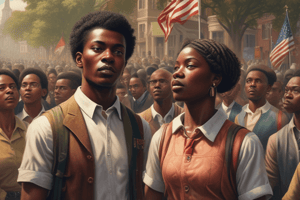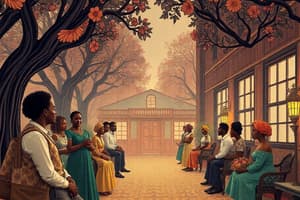Podcast
Questions and Answers
Between which time periods were Jim Crow laws enacted in the United States?
Between which time periods were Jim Crow laws enacted in the United States?
- 1900s to 1940s
- 1860s to 1880s
- 1940s to 1980s
- 1870s to 1960s (correct)
What was the primary purpose of Jim Crow laws?
What was the primary purpose of Jim Crow laws?
- To encourage interracial marriage
- To promote racial equality and integration
- To enforce racial segregation and discrimination (correct)
- To provide education and employment opportunities
In which era did Jim Crow laws emerge?
In which era did Jim Crow laws emerge?
- Civil Rights Movement
- World War II Era
- Industrialization Era
- Reconstruction Era (correct)
What was the outcome of the Plessy v. Ferguson Supreme Court case?
What was the outcome of the Plessy v. Ferguson Supreme Court case?
What was the impact of Jim Crow laws on African Americans' access to education?
What was the impact of Jim Crow laws on African Americans' access to education?
Who led the Montgomery Bus Boycott?
Who led the Montgomery Bus Boycott?
Flashcards are hidden until you start studying
Study Notes
Definition and Purpose
- Jim Crow laws were a set of racial segregation laws enacted in the United States between the 1870s and 1960s
- Designed to enforce racial segregation and discrimination against African Americans in the South
History
- Emerged during the Reconstruction Era (1865-1877) after the Civil War
- Gained momentum in the late 19th and early 20th centuries
- Peaked in the 1920s and 1930s
- Began to be dismantled in the 1950s and 1960s during the Civil Rights Movement
Key Provisions
- Segregation in public facilities, including:
- Schools
- Restaurants
- Theaters
- Hotels
- Restrooms
- Drinking fountains
- Restrictive voting laws, including:
- Literacy tests
- Poll taxes
- Grandfather clauses
- Separate and unequal facilities, including:
- Public transportation
- Housing
- Healthcare
- Anti-miscegenation laws, prohibiting interracial marriage
Impact
- Perpetuated racial segregation and discrimination
- Denied African Americans basic civil rights and social equality
- Limited access to education, employment, and economic opportunities
- Contributed to the growth of racial violence and terrorism
Notable Events and Figures
- Plessy v. Ferguson (1896): Supreme Court case that upheld segregation
- Brown v. Board of Education (1954): Supreme Court case that declared segregation in schools unconstitutional
- Montgomery Bus Boycott (1955-1956): Led by Dr. Martin Luther King Jr. to protest segregation on public buses
- Civil Rights Act of 1964: Prohibited discrimination based on race, color, religion, sex, or national origin
- Voting Rights Act of 1965: Prohibited racial discrimination in voting
Definition and Purpose
- Jim Crow laws were a set of racial segregation laws enacted in the United States between the 1870s and 1960s to enforce racial segregation and discrimination against African Americans in the South.
History
- Emerged during the Reconstruction Era (1865-1877) after the Civil War.
- Gained momentum in the late 19th and early 20th centuries.
- Peaked in the 1920s and 1930s.
- Began to be dismantled in the 1950s and 1960s during the Civil Rights Movement.
Key Provisions
- Segregation in public facilities, including schools, restaurants, theaters, hotels, restrooms, and drinking fountains.
- Restrictive voting laws, including literacy tests, poll taxes, and grandfather clauses.
- Separate and unequal facilities, including public transportation, housing, and healthcare.
- Anti-miscegenation laws, prohibiting interracial marriage.
Impact
- Perpetuated racial segregation and discrimination.
- Denied African Americans basic civil rights and social equality.
- Limited access to education, employment, and economic opportunities.
- Contributed to the growth of racial violence and terrorism.
Notable Events and Figures
- Plessy v. Ferguson (1896): Supreme Court case that upheld segregation.
- Brown v. Board of Education (1954): Supreme Court case that declared segregation in schools unconstitutional.
- Montgomery Bus Boycott (1955-1956): Led by Dr. Martin Luther King Jr. to protest segregation on public buses.
- Civil Rights Act of 1964: Prohibited discrimination based on race, color, religion, sex, or national origin.
- Voting Rights Act of 1965: Prohibited racial discrimination in voting.
Studying That Suits You
Use AI to generate personalized quizzes and flashcards to suit your learning preferences.




